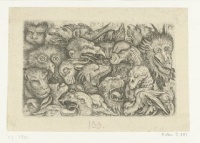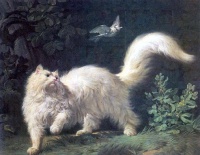Animal
From The Art and Popular Culture Encyclopedia
|
Related e |
|
Featured: |
The word "animal" comes from the Latin word animal, of which animalia is the plural, and is derived from anima, meaning vital breath or soul. In everyday colloquial usage, the word usually refers to non-human animals. The biological definition of the word refers to all members of the Kingdom Animalia. Therefore, when the word "animal" is used in a biological context, humans are included.
History of classification
Aristotle divided the living world between animals and plants, and this was followed by Carolus Linnaeus (Carl von Linné), in the first hierarchical classification. Since then biologists have begun emphasizing evolutionary relationships, and so these groups have been restricted somewhat. For instance, microscopic protozoa were originally considered animals because they move, but are now treated separately.
In Linnaeus's original scheme, the animals were one of three kingdoms, divided into the classes of Vermes, Insecta, Pisces, Amphibia, Aves, and Mammalia. Since then the last four have all been subsumed into a single phylum, the Chordata, whereas the various other forms have been separated out. The above lists represent our current understanding of the group, though there is some variation from source to source.
Consciousness
The sense in which animals can be said to have consciousness or a self-concept has been hotly debated; it is often referred to as the debate over animal minds. The best known research technique in this area is the mirror test devised by Gordon G. Gallup, in which an animal's skin is marked in some way while it is asleep or sedated, and it is then allowed to see its reflection in a mirror; if the animal spontaneously directs grooming behavior towards the mark, that is taken as an indication that it is aware of itself. Self-awareness, by this criterion, has been reported for chimpanzees and also for other great apes, the European Magpie, some cetaceans and a solitary elephant, but not for monkeys. The mirror test has attracted controversy among some researchers because it is entirely focused on vision, the primary sense in humans, while other species rely more heavily on other senses such as the olfactory sense in dogs.
A different approach to determine whether a non-human animal is conscious derives from passive speech research with a macaw (see Arielle). Some researchers propose that by passively listening to an animal's voluntary speech, it is possible to learn about the thoughts of another creature and to determine that the speaker is conscious. This type of research was originally used to investigate a child's crib speech by Weir (1962) and in investigations of early speech in children by Greenfield and others (1976). With speech-capable birds, the methods of passive-speech research open a new avenue for investigation.
See also
- Animal culture
- Animal cognition
- Animal sexual behaviour
- Animal trial
- Anthropomorphism
- Mammal
- Non-human
- Stereotypes of animals
- Ugly animal
- Zoomorphism





